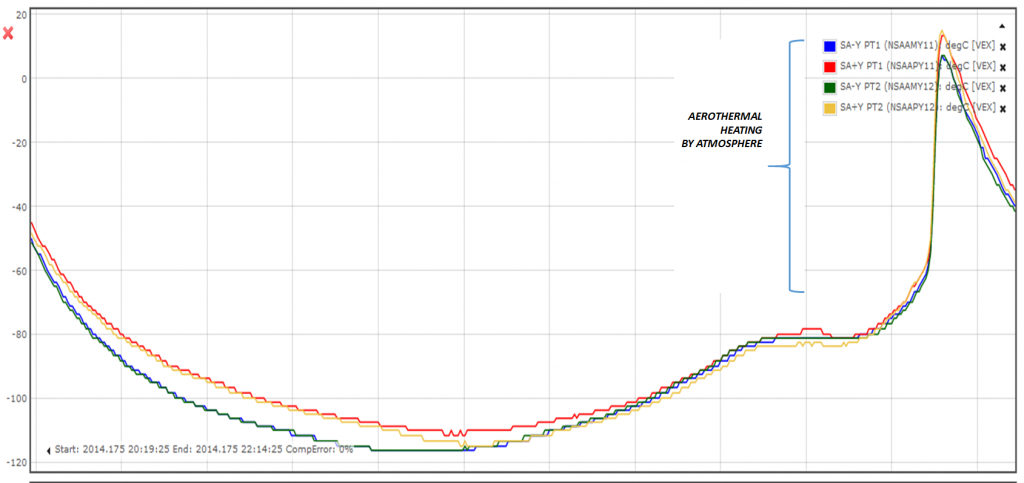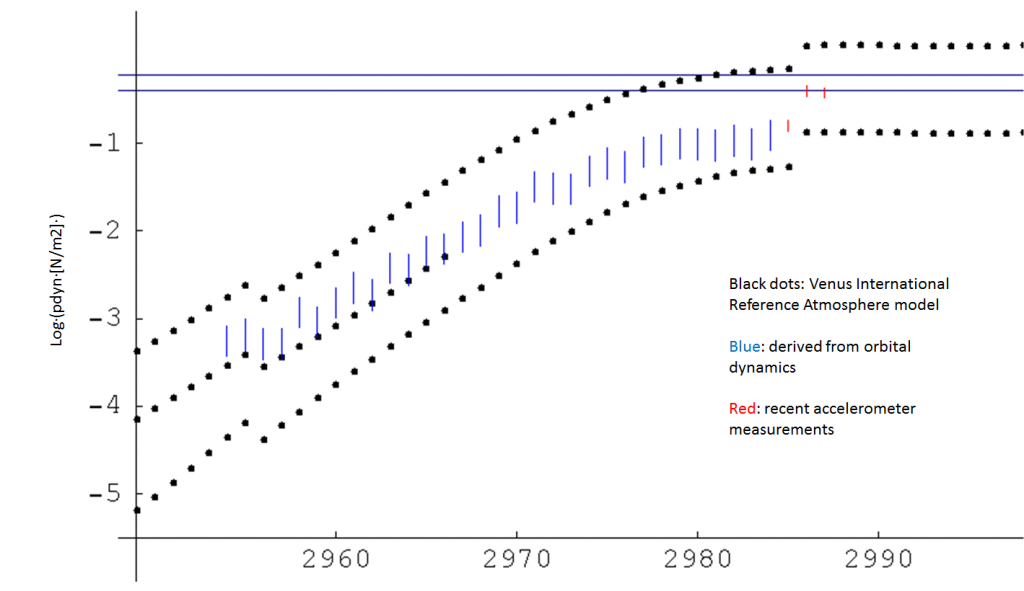The post below was contributed by Colin Wilson at the Dept. of Atmospheric, Oceanic and Planetary Physics, Oxford University, with inputs from the operations team at ESOC. Colin is Venus Express Science operations co-ordinator.
Here’s some more data from Venus Express as it conducts its aerobraking campaign.
In the past ten days, we saw the acceleration felt by the spacecraft as it dips into the atmosphere. However, it’s not these accelerations which threaten the spacecraft – instead, it’s the heating of the spacecraft which is more dangerous for Venus Express survival.
When the spacecraft enters the atmosphere, it’s moving at almost 10 km/s – that’s 36 000 km/h – so the elements of the spacecraft facing the flow are rapidly heated.

Solar array temperature profile during VEX braking mode orbit on 24 June 2014. Credit: ESA/C. Wilson
The plot above shows solar panel temperatures during an aerobraking pass on the 24 June. In the ~100-second duration of the passage through the atmosphere itself, it can be seen that the solar panel temperature sensor reading increases by 70 degrees!
The solar panels are cooled before aerobraking by pointing them at deep space rather than at the Sun – this cools them down to about -100 deg C. That’s why, despite the extremely rapid heating during aerobraking, the solar panel temperature sensors only get up to 10-15 deg C. To put this in context, the solar panels are typically at 50 deg C when they are facing the Sun in normal use. The temperatures of 10-15 deg C reached in this aerobraking pass are therefore not high enough to damage the solar panels.
However, the high rate of heating could also cause trouble; when heating is applied so suddenly, one gets strong temperature gradients in the spacecraft and its subsystems, which eventually could cause mechanical or other failures.
Different parts of the spacecraft will heat up at different rates; massive components like the spacecraft structure do not heat up quickly due to their heat capacity. On the other hand, the multi-layer thermal insulation, which envelopes the spacecraft, is composed of thin, light layers of metallised plastic film. These layers have a very small heat capacity, so they heat up extremely rapidly; they are not designed to retain their insulating properties at prolonged temperatures over 350 deg C.
This is probably the limiting factor in the aerobraking campaign – if the spacecraft is taken too low, the insulation layers will be heated up to such high temperatures that they may lose their insulating properties, which may lead to loss of thermal control of the spacecraft.
The second plot shows how the dynamic pressures encountered by the spacecraft have been increasing during the aerobraking campaign – this is a measure of the drag force experienced by the spacecraft.
In particular, it shows how the pericentre-lowering manoeuvre carried out on 23 June resulted in a sharp increase of dynamic pressure, bringing us into the target range of 0.4-0.6 N/m^2.


Discussion: 3 comments
Very interesting results, but a little difficult to understand as there are no correlation between the orbit number and the day it was done. On the diagram where the day and hour of nearest approach is depicted the colour scheme is not explained. On which part of the spacecraft are the temperature and the dynamic loads measured? And why are the height above the planet NOT referred? As that would correlate with temperature, dynamic pressure more than the orbit number. Or, is the orbit number given for later reference to these data?
Pretty! This has been an incredibly wonderful article.
Thank you for providing this info.
Muchas gracias por compartir artículos como
este.